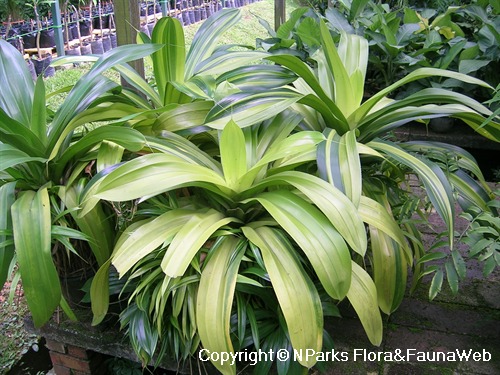
Back
Pandanus houlletii Carrière
| Family Name: | Pandanaceae |
| Common Name: | Pandan Hutan, Mengkuang Hutan |
Name
Classifications and Characteristics
| Plant Division | Angiosperms (Flowering Seed Plants) (Monocotyledon) |
|---|---|
| Plant Growth Form | Tree (Small (6m-15m)), Shrub |
| Lifespan (in Singapore) | Perennial |
| Mode of Nutrition | Autotrophic |
| Plant Shape | Fountain (Palm-like) |
| Maximum Height | 2.4 m |
Biogeography
| Native Distribution | Peninsular Malaysia and Singapore |
|---|---|
| Native Habitat | Terrestrial (Primary Rainforest, Secondary Rainforest) |
| Preferred Climate Zone | Tropical |
| Local Conservation Status | Native to Singapore (Critically Endangered (CR)) |
Description and Ethnobotany
| Growth Form | It is a tree or shrub up to 2.4 m tall. |
|---|---|
| Foliage | Its leaves are linear, tapering gradually to sharp points, coppery purple when young, dark green when mature, with very small spines, and 240 by 120 cm. |
| Flowers | Its male inflorescence is 60 cm long or more. |
| Fruit | Its female syncarp (fleshy compound fruit) is solitary, orange, and fleshy |
| Habitat | It grows in lowland forests. It is found locally in the forests around MacRitchie Reservoir. |
| Cultivation | It can be propagated by seed or division of the side shoots. |
| Etymology | Latin pandanus, from the Malayan name pandan, for screw-pines (Pandanus species); Latin Houlletia, commemorating M. Houllet, the head gardener at the Jardin des Plantes, Paris |
| Ethnobotanical Uses | Food (Fruit or Vegetable): Its fruit is soft and sweet-tasting, like a pineapple. Others: Its leaves are used to make mats. |
Landscaping Features
| Landscaping | It can be grown in parks and gardens under semi-shaded environments for its attractive purplish-brown young leaves and fountain-shaped form. |
|---|---|
| Desirable Plant Features | Ornamental Foliage, Ornamental Form |
| Landscape Uses | Parks & Gardens |
| Usage Hazard - Cons | Spines/Thorns - Leaf |
Plant Care and Propagation
| Light Preference | Semi-Shade |
|---|---|
| Water Preference | Moderate Water |
| Plant Growth Rate | Moderate |
| Rootzone Tolerance | Moist Soils, Well-Drained Soils, Fertile Loamy Soils |
Image Repository
Others
| Master ID | 32038 |
|---|---|
| Species ID | 6443 |
| Flora Disclaimer | The information in this website has been compiled from reliable sources, such as reference works on medicinal plants. It is not a substitute for medical advice or treatment and NParks does not purport to provide any medical advice. Readers should always consult his/her physician before using or consuming a plant for medicinal purposes. |






